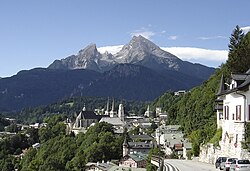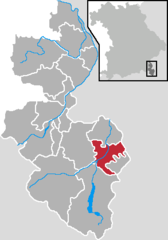Berchtesgaden
Municipality in Bavaria, Germany From Wikipedia, the free encyclopedia
Municipality in Bavaria, Germany From Wikipedia, the free encyclopedia
Berchtesgaden (German pronunciation: [ˈbɛʁçtəsˌɡaːdn̩]) is a municipality in the district Berchtesgadener Land, Bavaria, in southeastern Germany, near the border with Austria, 30 km (19 mi) south of Salzburg and 180 km (110 mi) southeast of Munich. It lies in the Berchtesgaden Alps. South of the town, the Berchtesgaden National Park stretches along three parallel valleys.
Berchtesgaden | |
|---|---|
 Berchtesgaden and the Watzmann in August 2010 | |
Location of Berchtesgaden within Berchtesgadener Land district  | |
| Coordinates: 47°37′53″N 13°0′15″E | |
| Country | Germany |
| State | Bavaria |
| Admin. region | Oberbayern |
| District | Berchtesgadener Land |
| Government | |
| • Mayor (2020–26) | Franz Rasp[1] (CSU) |
| Area | |
| • Total | 34.78 km2 (13.43 sq mi) |
| Elevation | 700 m (2,300 ft) |
| Population (2023-12-31)[2] | |
| • Total | 7,698 |
| • Density | 220/km2 (570/sq mi) |
| Time zone | UTC+01:00 (CET) |
| • Summer (DST) | UTC+02:00 (CEST) |
| Postal codes | 83471 |
| Dialling codes | 08652 |
| Vehicle registration | BGL |
| Website | www |
The Kehlstein mountain (1,835 m or 6,020 ft), with its Kehlsteinhaus (Eagle's Nest), is located in the area.
Berchtesgaden, Upper Bavaria (Achental), earlier Perchterscadmen, Perhtersgadem, Berchirchsgadem, Berchtoldesgadem; the word underwent a Latin distortion of Old High German parach, Romance bareca 'hay shed'. After the basic meaning was forgotten, a variant word of Old High German gadem 'room, one-room hut' was added, implying the same meaning: 'hay shed'. Cf. Old High German muosgadem 'spice room'.
There was a folk etymology that supported a derivation based on the legendary figure of Frau Perchta (Berchta), a woman (Holle < Holda 'well disposed, dear') with good and bad changing features, who was venerated on Perchtertag (Epiphany) and was sworn to during the Perchta procession.[3]
This section needs additional citations for verification. (July 2023) |
The first known record of the area, from 1102, mentions the area's rich salt deposits. Salt mining began in the area in 1517, and subsequently produced much of Berchtesgaden's wealth.[4]

The town and its surroundings belonged to the Berchtesgaden Provostry, an independent state of the Holy Roman Empire (called Fürstpropstei Berchtesgaden) and was ruled by the Prince-provost of the Augustine monastery in the town. It remained independent until the Reichsdeputationshauptschluss in 1803. During the Napoleonic wars, Berchtesgaden changed hands a few times, such as in 1805 under the Treaty of Pressburg, when the area was ceded to Austria.
Berchtesgaden came under the rule of the Kingdom of Bavaria in 1810. It soon became popular with the Bavarian royal family, the House of Wittelsbach, who often visited Königssee and maintained a hunting residence in the former Augustine monastery (still used today by Franz, Duke of Bavaria). Tourism began to evolve and several artists came to the area, which reportedly gave rise to Malereck ("painters' corner") on the shore of the Königssee in nearby Schönau am Königssee. The most famous author who lived in Berchtesgaden was Ludwig Ganghofer.

Adolf Hitler began vacationing in the Berchtesgaden area in the 1920s. He purchased a home in the Obersalzberg above the town on the flank of the Hoher Goll and began extensive renovations on his Berghof in the following years. As other top Third Reich figures, such as Hermann Göring, Joseph Goebbels, Martin Bormann, Heinrich Himmler, and Albert Speer, began to frequent the area, the Nazi Party began to purchase and requisition land in the Obersalzberg.[5]
To serve as an outpost of the German Reichskanzlei (Imperial Chancellery), Berchtesgaden and its environs (Stanggass) saw substantial expansion of offices, security, and support services, mainly on the Obersalzberg. Included in the town were a new railway station, with a reception area for Hitler and his guests, and an adjacent post office. The Berchtesgadener Hof Hotel, where famous visitors such as Neville Chamberlain and David Lloyd George stayed, was substantially upgraded.
Berchtesgaden was where Adolf Hitler met Neville Chamberlain in 1938 before the Munich Agreement; see Berchtesgaden meeting.
Even though a feared Alpine Fortress last stand of the Nazi Regime in the Alps failed to materialize late in World War II, the Allies launched a devastating air raid on the Berchtesgaden area in the spring of 1945. The 25 April bombing of Obersalzberg did little damage to the town. On 4 May, forward elements of the 7th Infantry Regiment of the 3rd Infantry Division arrived[6] and received the town's surrender.[7]
After the war, Berchtesgaden became a military zone and most of its buildings were requisitioned by the U.S. Army. Hotel Platterhof was rebuilt and renamed the General Walker Hotel in 1952.[8] It served as a U.S. Armed Forces Recreation Center through the Cold War and beyond.[9] Remnants of homes of former Nazi leaders were demolished in the early postwar years, though traces of some remained. In 1995, fifty years after the end of World War II and five years after German reunification, the AFRC Berchtesgaden was turned over to Bavarian authorities to facilitate military spending reductions mandated within the Base Realignment and Closure program by the US Congress and Pentagon during the administration of President Bill Clinton.[9] The General Walker Hotel was demolished in 2000–2001.
In 1986, Berchtesgaden was a first-round candidate city to host the XVI Olympic Winter Games to be held in 1992. The vote eventually went to Albertville, France, in October of that year.[10]


The Hotel Türken, which was near the Nazi buildings and was often used by the SS and then by the Generalmajor of the Police, was badly damaged in 1945. It was rebuilt in 1950 and reopened as a hotel before Christmas.[11] Visitors can still explore the historic underground hallways and tunnels that had been used by the Nazis.[12][13][14]
In 1972, local government reform united the then-independent municipalities of Salzberg, Maria Gern and Au (consisting of Oberau and Unterau) under the administration of the town of Berchtesgaden. Another suggested reform uniting all remaining five municipalities in the Berchtesgaden valley (Bischofswiesen, Ramsau, Marktschellenberg and Schönau) failed to gain enough popular support; it passed in Berchtesgaden but failed everywhere else.
The Berchtesgaden National Park was established in 1978 and has gradually become one of Berchtesgaden's largest draws. Mass tourism is confined to a few popular spots, leaving the rest to nature-seekers. Other tourist draws are the Königssee, the salt mine, the Kehlsteinhaus, open seasonally as a restaurant, and the Dokumentationszentrum Obersalzberg museum about the area's history, operated by the Munich Institut für Zeitgeschichte since 1999.[15][16][17]
Recreational and competitive sports have grown in importance. The town's ski slope is popular. The Königssee bobsleigh, luge, and skeleton track has hosted ski-running and several international events and competitions. Berchtesgaden's most famous sports personality is Georg Hackl, a multiple Olympic medal winner. The city is home to the International Luge Federation (FIL).
Unlike the northern part of Berchtesgadener Land and the Salzburg area, Berchtesgaden has virtually no manufacturing industry.
Berchtesgaden Central Station is connected by the Salzburg–Berchtesgaden railway to the Rosenheim–Salzburg railway at Freilassing.
The Bavarian state government facilitated the erection of a hotel, which opened in 2005 and is operated by the InterContinental Hotels Group.[16] Since May 2015, the hotel has been the Kempinski Berchtesgaden.[18][19]
Berchtesgaden's neighbouring towns are Bischofswiesen, Marktschellenberg, Ramsau, and Schönau am Königssee.
The municipality counts the following villages which are (Ortsteil): Am Etzerschlößl, Anzenbach, Hintergern, Metzenleiten, Mitterbach, Oberau, Obergern, Obersalzberg, Resten, Unterau, Untersalzberg I, Untersalzberg II, and Vordergern.

In the 1760s several anonymous toy symphonies (including the famous Toy Symphony often attributed to Haydn or Leopold Mozart) were composed at Berchtesgaden, then a manufacturing centre for toy instruments.[20] Some of the instruments used for these can be seen in the Museum Carolino Augusteum in Salzburg.[21]
Seamless Wikipedia browsing. On steroids.
Every time you click a link to Wikipedia, Wiktionary or Wikiquote in your browser's search results, it will show the modern Wikiwand interface.
Wikiwand extension is a five stars, simple, with minimum permission required to keep your browsing private, safe and transparent.